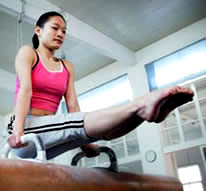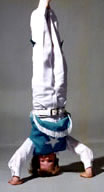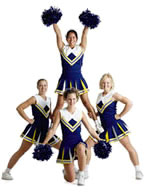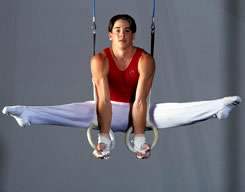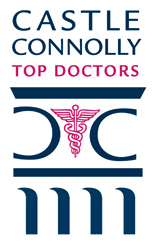Thomas J. Parr, M.D., F.A.C.S.
| |||||
| WELCOME • ABOUT DR. PARR
• PATIENT INFO • en español SPORTS MEDICINE • ARTICLES/LINKS • CONTACT US • PAY YOUR BILL ONLINE |
|||||
|
||||||||
Cheerleading and GymnasticsIn many respects, gymnastics and cheerleading are more likely to be distinguished by clothing than by the nature of the two sports. Cheerleaders wear skirts, body suits and shells, while gymnasts wear leotards. Each has special shoes designed for its specific events. Both sports involve extensive practice, where personal conditioning is critical and where injuries mainly occur during the landings or dismounts. In fact, one of the major problems with these two sports leading to potential serious injuries is that they both are year-round sports. Neither has an “off season” where the participants can take time off to let their bodies heal. Thus, even minor injuries must be taken seriously to be sure they are properly healed to prevent more serious injuries from developing. Cheerleading is one of the most dangerous sport for girls, and gymnastics is close behind. This number may be somewhat misleading, however, since more elementary school age girls than boys tend to participate in these sports. In both gymnastics and cheerleading, learning how to fall safely is extremely important in reducing the chances for severe injuries. Proper falling techniques are taught in other sports and need to be a greater part of these. If spotters alone were effective, the injury rates for cheerleading and gymnastics would not be so high. Regular practice in falling safely must be as much a part of the curriculum as any other skill. Unless your gymnastics or cheerleading program stresses learning how to fall forwards, backwards, to both sides, and from a variety of heights, and practices it regularly, safety is not the number one priority of that school -- no matter what the school’s reputation otherwise and no matter how long that school has existed. Don’t just take the school’s word that training on proper falling techniques is included. Unless you actually observe “fall training” regularly in the course of weekly drill, it is not happening. Parents need to evaluate the professional educational levels of prospective coaches. Because of the nature of cheerleading and gymnastics, it is important for today’s coaches to have a good understanding of basic anatomy, biomechanics, kinesiology, and strength training. Coaches also need to know how to use this knowledge to train today’s students. This has not been regarded as important in the past, so not all of today’s coaches have received this education, and not all programs will include these aspects of training in their programs. Overall physical conditioning is extremely important. Injuries occur when the strength of various muscles is not appropriately balanced or when the muscles are too fatigued to support the forces which are exerted during a gymnastic movement or a cheerleading stunt. This is especially true for growing children. Part of each practice should include elements of personal conditioning involving core body strength (lower back and abdomen), proprioception (sense of balance), and flexibility, as well as shoulder, arm, leg, and ankle strengthening. Parents can help their children develop and maintain better ankle strength and improved proprioception with something as simple as walking forwards and backwards for a few minutes every day on a 2x4 or 2x6 plank placed on the floor. When it starts to get easy, have them try doing it with their eyes closed. The cheerleading coach must teach skills in their proper order. It
is extremely important that no member of the team be allowed to be a
part of any stunt above that individual’s skill level, even if it means
a stunt cannot be performed. To do so would be risking injury to one or
more members of the team. Thus, the cheerleading coach must assess each
student individually and must track each individual student’s progress
carefully. Gymnastics coaches should hold the Safety/Risk Management Certification from USA Gymnastics. This certification is available both online and in class settings. For cheerleading, your coach should hold a coaching certification from the American Association of Cheerleading Coaches and Administrators (AACCA) or the National Council for Spirit Safety and Education (NCSSE). The AACCA certification can be obtained with only four hours of course review and a 100 question multiple choice exam, with a passing grade being 70%. The NCCSE certification is much more advanced certification, requiring completion of several courses on a variety of safety considerations. Texas does not require any cheerleading coach certifications. According to the Dallas Morning News, (September 5, 2008), “Cheerleading is not considered a sport in Texas and therefore not overseen by the University Interscholastic League (UIL).” Another problem in Texas is that many high school cheer teams are picked by student body vote rather than by tryouts based upon training and skill. These safety issues need to be addressed by local school boards and the UIL. BASIC SAFETY RULES: Students must be serious about their training. Practices and competitions are not places to misbehave or to be otherwise distracted. It is extremely important for students to be given frequent breaks for water. Becoming thirsty means the body is already getting dehydrated, which will affect performance and can lead to increased chances for injury. PROPER NUTRITION AND DIET: CHEERLEADING INJURIES: Cheerleading parents need to be sure your child knows exactly what his or her ability level is, with the understanding that trying to do harder stunts before the coach teaches them is extremely dangerous. Youngsters also need to be do cheerleading activities only under supervised settings and not in the house or back yard. Parents wanting more information about cheerleading safety can consult Parents Guide to Cheerleading Safety - AACCA. GYMNASTICS INJURIES: The study also indicated that girls are more likely to have upper extremity (shoulder, arm, elbow, wrist, and hand) injuries than boys, but boys are more likely to have head and neck injuries. Many of these injuries were due to mishaps with handsprings, flips and cartwheels or round-offs. Because gymnasts do events where they support their entire weight on their arms and hands, recent MRI studies have shown that early damage is being done to those joints, not typical for non-gymnasts of similar age. Additional study is needed to better understand this problem. Meanwhile, perhaps limiting the amount of time spend doing such events within a week’s training period might be a reasonable consideration. Stress fractures of the spine, known as spondylolysis, are more common to gymnastics than cheerleading because of the arching of the back during certain moves and because of the continual impact of dismounts. Pre-school aged children have special physiological needs. While they are ready to learn some basic tumbling skills, more advanced gymnastic skills should not be taught until they are older. Children under the age of 7 should not be permitted to do backbends because their spines are not developed enough prior to that age. A REASONABLE GYMNAST’S GOAL: YOUR ORTHOPEDIC SURGEON: It is especially important to have cheerleading and gymnastic injuries in growing children and young teenagers checked by an orthopedic surgeon when there is any question about an injury possibly involving a bone’s growth plate (located near the ends of each bone). If the growth plate (also called the “physis”) is injured, it could affect how the bone will grow. If untreated, the bone could become deformed during further growth. Parents need to ask the orthopedic surgeon for clear instructions on what conditioning exercises their children can and should do to maintain overall fitness while an injury is healing. It is best to have these instructions in writing so there will not be any confusion or miscommunication between the doctor and the coach. But unless overall fitness is maintained, the student will be more likely to have a repeat or a new injury when returning to practice. — Tom Parr, M.D. |
COMMON SPORTS INJURIES & SAFE PARTICIPATION
Baseball & Softball
SPORTS MEDICINE RECOGNITION
Recognized as one of the "Top Sports Medicine Orthopedic Surgeons in the USA" by Castle Connolly. Dr. Parr has been named as an "Outstanding Orthopedic Surgeon of Texas", as seen in SPORTS ILLUSTRATED.
SPEAKER'S PROGRAM:
|
|||||||
| 14090 Southwest Freeway #130 Sugar Land TX 77478 Phone: 281-491-7111 |
© Copyright 2009-2018 Thomas J. Parr, M.D. |
